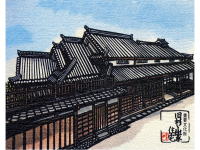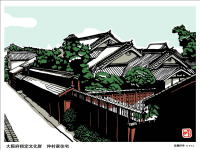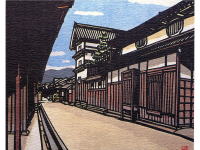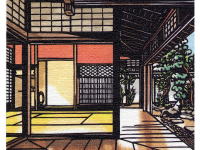富田林寺内町の探訪
I'm glad to intorduce an old town, Jinaimachi, Tondabayashi, Osaka, Japan as a national historic district and heritage site.
It takes 30 minutes from Osaka city to Tondabayashi station by Kintetsu railways. A 10-minutes walk will take you to the historic town.
ギャラリー
History of jinaimachi town, tondabayashi, a historic district, japan
| 【Tourist guide to Jinaimachi town, Tondabayashi, a historic district and heritage site of Japan, History Page 2/4】 | |
| Development of the merchant town in the rural area by distribution of commercial
crops. As cultivating rapeseed and cotton became popular in villages nearby in the 18th century, wholesalers that purchased, processed and sold them had increased. Tondabayashi became a commerce center in Ishikawa River valley. Such manufacturers and wholesalers as sake brewries made of rice, rapeseed oil dealers and traders of cotton grown in Kawachi region, had gradually began to flourish from the Genroku and Hoei period. While large stores cum residences of these wholesalers were being built, more merchants nearby as well as around the country came to the town and further prosperity of the town could be realized and the whole scale of commerce and business transactions had grown up widely. In the meanwhile, the medieval characterics of town as a mission with autonomy had been gradually lost and Tondabayashi achieved economic development of the region to be a commercial town in the rural area during the early modern period. |
|
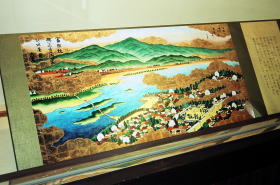 The scroll of Kawachi regional attractions(1801) |
It was described as follows in the scroll of Kawachi regional attractions
. Though it used to be a large field called Tonda-ga-Shiba, now there are a number of stores one after another and many merchants, particularly a number of sake breweries as excellent quality of groundwater was available. |
| The trade name of merchants had been until recently named after the name
of village where they originally used to be before they moved into Tondabayashi,
such as Hirao-ya (Koshii family), Bettsui-ya (Hashimoto family), Kuroyama-ya (Tamori family),Shindo-ya(Kitano family), Itamochi-ya、Kishi-ya (Sugimoto family), Asuka-ya、Iwase-ya(Okutani family), Sakata-ya (Tanaka family). (Source) Quoted from "Tondabayashi" published by Tondabayashi Chamber of Commerce and Industry (September, 1974) and from "Tondabayashi Jinaimachi town" published by Tondabayashi Board of Educationthan (1975) respectively. |
|
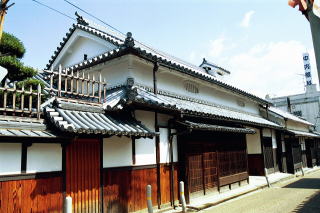 Tamori residence who used to do business as Kuroyama-ya as cotton wholasaler |
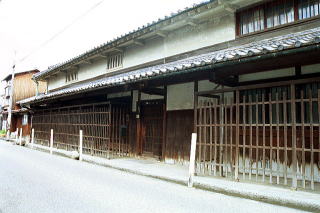 Kitano residence who used to do business as Shindo-ya as cotton wholasaler |
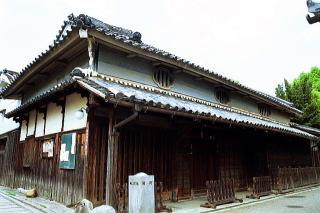 Hashimoto residence who used to do business as Bettsui-ya as sake brewery |
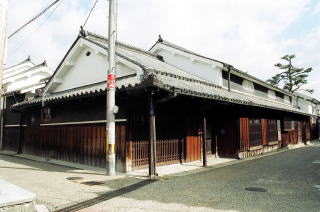 Kuzuhara residence who used to do business as Totsukawa-ya as sake brewery |
| Prosperity of the merchants It used to be a common practice among the wealthy merchants' family that children of each merchant had to go on apprenticeship in Sakai, Osaka pref. to learn commerce, and back to the town, then they exerted quotient measures what they learned. Not only quotient measures, they also learned saving how they could manage expenses to meet earnings and devoted themselves to eliminating the unnecessary expenses. Therefore, they could spare the surplus savings for a house, a tool and household effects including household articles. So, they could elaborate on the form of Kemudashi, or overtopped small roof for smoke ventilation, and could spend money on wooden exterior of lattices extravagantly.Those architectual buildings which stay now and whose value have not been deteriorated in the least were created. Even though they behaved extravagantly, thay did not make a show of extravagance and you can observe delicacy with the restraint, as it is, for sure, due to sophistcation of Kinai region, advanced cultural district at the time. When economic status was turning from Sakai to Osaka (Naniwa), this town was also directing the face to Osaka. Then, apprenticeship for children was also moved in Semba, Osaka. Many of those old merchants' family have still relatives by marriage in Sakai and Semba. Although it had originally evolved from the landowners, Tondabayashi was also successful as a commerce. They succeeded in sake liquor brewerers utilizing clear stream of Ishikawa river, cotton whosalers who dealt with raw cotton, a speciality in Kawachi region, and timber traders who had cut their own trees of their mountains in Kongo maountains range and wholesale drug traders. Source: "Historic townscape, color edition" written by Toshiro Naya, photo by Jiro Hashimoto, published by Tankou-sha in Kyoto on October 23, 1975. (a collection of Tondabayashi municipal central library) |
|
| Prosperity of sake brewering industry Ther used to be seven family of sake breweries in Todabayashi, whose total production was equivalent to 616 koku units of rice, or 92,400kgs or 110,880 litters. (The koku is referred in the remark below). Out of the seven breweries, the five family of breweries such as Chozaemon Sugiyama, Tokubei Nakamura, Mohei Kuzuhara, Isuke Okutani Chuubei hashimoto had continued business from 1834 through 1870. The total production per year of the five breweries reached about 4380koku, representing more than half of the whole production of 72 breweries in Kawachi region. The products were sold to other regions, particlularly transportated to Edo (Tokyo) . The number of barrels which were transportated to Edo in 1716, equivalent to 600 koku units of rice. Remark: 1 koku is an old unit equivalent to 150kgs or 180 litter of rice for brewing, which is corresponded to the assumed yearly consumption of rice per adult. Source: "Tondabayashi" published by Tondabayashi Chamber of Commerce and Industry in September 1974 and "Tondabayashi Jinaimachi" published by Tondabayashi Board of Education in 1975. |
|
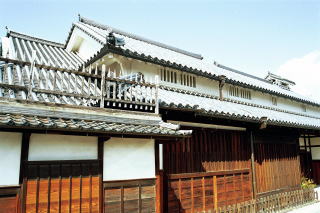 Former Sugiyama residence which used to do business as Wataya |
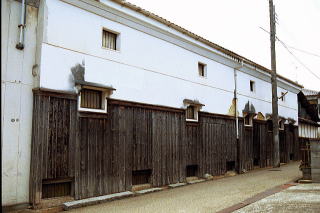 Sake storehouse of Ishida residence which used to do business as Banri-no-Haru |
| 【Tourist guide to Jinaimachi town, Tondabayashi, a historic district and heritage site of Japan, History Page 1/4】 | |
| 【Tourist guide to Jinaimachi town, Tondabayashi, a historic district and heritage site of Japan, History Page 2/4】 | |
| 【Tourist guide to Jinaimachi town, Tondabayashi, a historic district and heritage site of Japan, History Page 3/4】 | |
| 【Tourist guide to Jinaimachi town, Tondabayashi, a historic district and heritage site of Japan, History Page 4/4】 | |
Information

Location
Jinaimachi town, Tondabayashi city, a national historic preservation district
and heritage site of Japan, which is located in the south-eastern part
of Osaka prefecture, the western part of Japan
Directions to Jinaimachi town, Tondabayashi
It is a 10-minute walk from the Tondabayashi Staion or the Tondabayashi
Nishiguchi Station of Kintetsu Nagano line.
From Kansai International Airport
Airport Limousine Bus service available bound for Kawachi Nagano Station.
(60 minutes) Please take Kintetsu railways from Kawachi Nagano to Tondabayashi.(15
minutes)
From Osaka International Airport (Itami Airport)
Airport Limousine Bus service available bound for Abenobashi Station. (30
minutes) Please take Kintetsu railways from Abenobashi terminal to Tondabayashi.(30 munites)
From JR Shinkasen Shin-Osaka station or
Osaka (Umeda) station
Please take Subway Midousuji line from Shin-Osaka station or Osaka (Umeda)
station to Tennoji Station. (20~30 minutes) Please change trains at Tennoji
and take Kintetsu railways from Abenobashi terminal to Tondabayashi. (30
minutes)
The site-seeing map available in English
Please stop by to the Tourist Information Cetnter or Jinaimachi Visitor
Center.
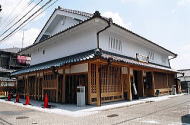
Jinaimachi Kouryuukan,
Town Community Center
(Visitor Center)
Address
9-29, Tondabayashi-cho, Tondabayashi city, Osaka, 584-0033, Japan
TEL.+81-(0)721-26-0110
FAX.+81-(0)721-26-0110
open 10a.m. until 5 p.m.
closed on Monday
Restrooms
Available at Jinaimachi Visitor Center (Jinaimachi Kouryuukan), Jinaimachi
Center and Jinaimachi Tenbou Hiroba (Viewing Terrace)
Visitor Parking
Road width is very narrow in Jinaimachi town. If traveling by car, please
use Tondabayashi Municipal east parking newly opened in February 2014 (Toll
parking).
You can park the minibus for groups and passenger cars for general use.
Only one parking lot available for minibus, you must book it in advance
with Tondabayashi City Hall. A 15-minute walk to the Jinaimachi Visitor
Center and 5 minute walk up to the former Sugiyama family house, an important
national cultural property.
You will note that the large tourist bus for groups is requested to be
parked at the Tondabayashi City Hall No. 2 parking lot alongside the old
Route 170 (It must be booked in advance to City Hall). 20-minute walk to the Jinaimachi
Visitor Center and 10 minute walk up to the former Sugiyama family house,
an important national cultural property. Thank you in advance for your
kind cooperation.
